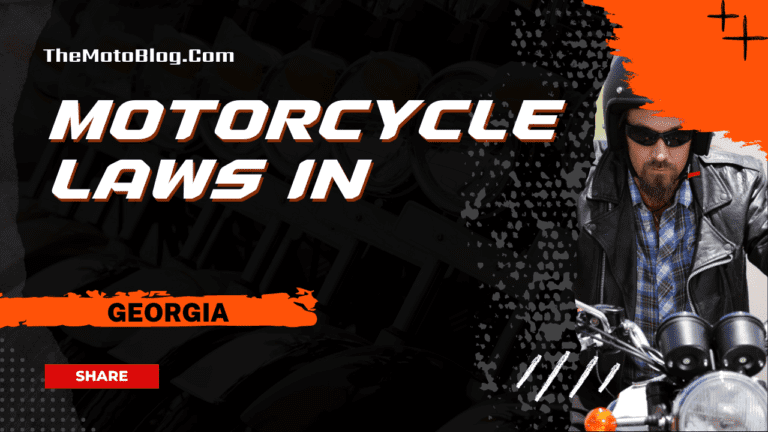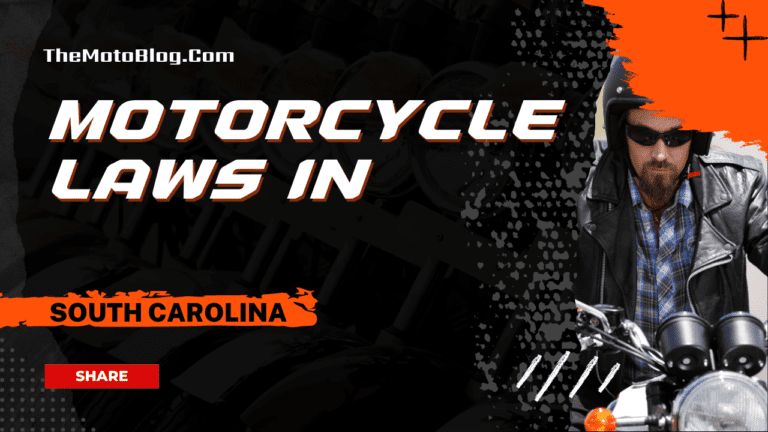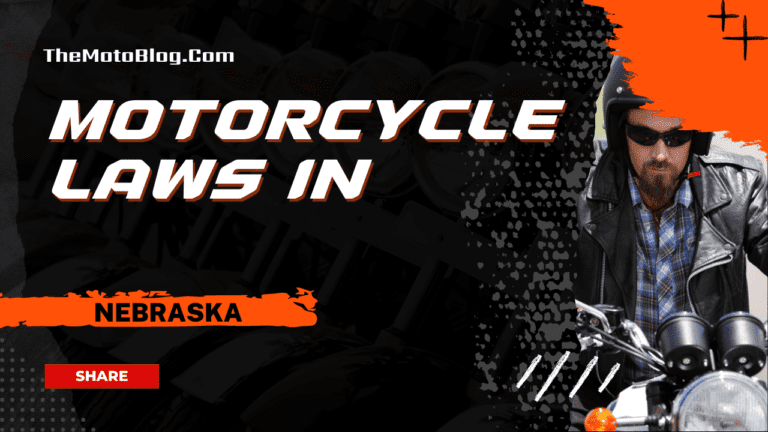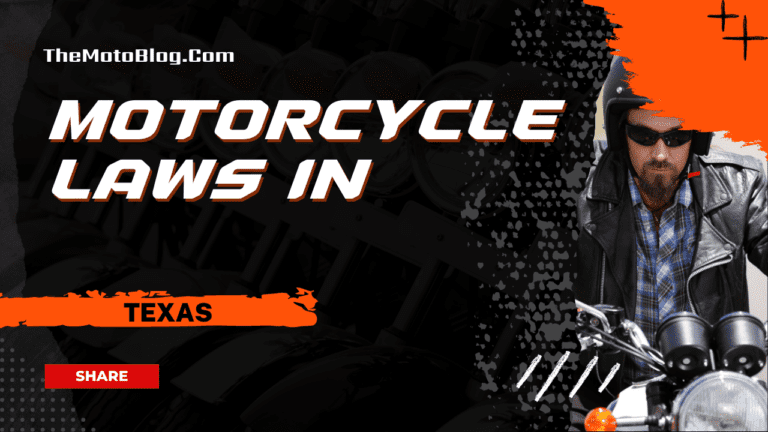Motorcycle Laws in Oklahoma: An Expert’s Guide on What You Need to Know
Oklahoma law, in particular, has a few unique aspects when it comes to motorcycling. For starters, did you know that every biker within our borders is required by law to wear a helmet until they turn 18.That’s right—regardless of how skilled or confident you might be on your bike, if you’re underage, strapping on a helmet isn’t negotiable.
Additionally, eye protection is a must-have unless your motorcycle is equipped with a windscreen. This requirement may seem trivial but trust me—it’s crucial for keeping dust and debris out of your eyes as you cruise down Oklahoma’s highways and backroads. Now that we’ve covered some basics let’s delve deeper into Oklahoma’s motorcycle laws and what they mean for riders like us.
Key Takeaways
- Oklahoma law requires every biker under the age of 18 to wear a helmet
- Eye protection is required for all bikers in Oklahoma unless the motorcycle is equipped with a windscreen
- Unlike some states, lane splitting (maneuvering between lanes of traffic) is prohibited in Oklahoma
- No set minimum age for passengers is specified in Oklahoma, but they must be able to reach the footrests and hold onto the rider securely
- Helmets are mandatory for riders and passengers under 18
- Motorcycle riders in Oklahoma must have liability insurance coverage
- Minimum liability coverage includes $25,000 for bodily injury or death per person, $50,000 for total bodily injury or death if multiple people are hurt in one accident, and $25,000 for property damage
- A unique enforcement in Oklahoma’s laws is the “No-Pay/No-Play” rule, which limits compensation for uninsured drivers in an accident.
- Riding under the influence of alcohol or drugs holds severe penalties in Oklahoma, including fines and possible jail time.
- All motorcycle riders in Oklahoma must pass a state-approved motorcycle endorsement process, proving their competence in handling two-wheeled machines.
Motorcycle laws in Oklahoma require helmets only for riders under the age of 18, which is in line with some of its neighboring states while contrasting with others. For instance, motorcycle laws in Texas have a similar stipulation for riders under 21, whereas motorcycle laws in Arkansas mandate helmets for those under 21, or without proper insurance or safety course completion. Moving north, motorcycle laws in Kansas require helmets for riders under 18, similar to Oklahoma’s law. However, motorcycle laws in Colorado enforce helmet usage only for riders and passengers under 18. To the east, motorcycle laws in Missouri mandate helmets for all riders. The variations in helmet laws between Oklahoma and its neighboring states highlight the complex and diverse nature of motorcycle regulations across the region. Riders traversing these states must be cognizant of these differences to ensure compliance with local laws and maintain safety on the roads.
Understanding Oklahoma’s Motorcycle Laws
I’ve spent a lot of time studying the motorcycle laws in various states, and I have to say, Oklahoma has some unique ones. Let me break them down for you.
Firstly, helmets. If you’re under 18 and riding a motorcycle in Oklahoma, it’s required by law that you wear a helmet. This applies whether you’re driving or just catching a ride as a passenger.
Secondly, the eye protection rule is non-negotiable. Regardless of your age or level of experience on two wheels, everyone must wear some form of eye protection while riding in this state.
Next up is insurance. In Oklahoma, every motorcyclist must carry liability insurance coverage — no exceptions.
Then there’s the subject of lane splitting – maneuvering between lanes of slowed or stopped traffic. It may be allowed in some states but not here; lane splitting is prohibited under Oklahoma law.
There are additional rules too like handlebar height restrictions and noise regulations but these mentioned above are the key ones every rider should know about.
The Importance of Motorcycle Endorsement in Oklahoma
If you’re planning to ride a motorcycle in the Sooner State, it’s critical that you understand a key requirement: Motorcycle Endorsement. This isn’t just a piece of paper or another bureaucratic hoop to jump through. It’s about safety and legality on Oklahoma roads.
Motorcycle endorsement serves as an official nod from the state that confirms your competence in handling two-wheeled machines. Well, for starters, it’s illegal to operate a motorcycle without endorsement on your license in Oklahoma. Riding without one could lead to fines or even suspension of your driving privileges.
But there’s more to consider than just avoiding penalties. An endorsed driver is believed to be safer on the roadways. When you go through the process of getting your motorcycle endorsement—completing required courses and passing tests—you’re not simply ticking boxes; you’re learning important skills and knowledge that may save lives.
Let me give you some numbers here:
| Year | Percentage Increase in Motorcycle Accidents |
|---|---|
| 2015 | 8% |
| 2016 | 12% |
| 2017 | 16% |
The table above shows how motorcycle accidents have increased over recent years in Oklahoma. It’s alarming! A significant portion of these incidents involved riders who didn’t possess a valid motorcycle endorsement.
Here are some benefits when having an endorsement:
- Legality: As mentioned earlier, riding without an endorsement can cause legal troubles.
- Safety: Proper training decreases risk levels in riding motorcycles.
- Insurance Premiums: Insurance companies often offer lower rates for endorsed riders due their perceived lower risk profile.
Helmet Requirements: What You Need to Know
When it comes to motorcycle laws in Oklahoma, one area I want to dive into is helmet requirements. Understanding these regulations can keep you on the right side of the law and ensure your safety while riding.
In Oklahoma, helmet use is age-dependent. Riders under 18 years must wear a helmet whenever they’re on a bike. That’s not optional – it’s mandatory. However, if you’re over 18, wearing a helmet becomes a personal choice.
Let’s break that down:
- Under 18: Helmet required
- Over 18: Helmet optional
Despite this leniency for older riders, I’d like to point out that helmets are proven lifesavers in accidents. The National Highway Traffic Safety Administration estimates that helmets reduce the risk of head injury by 69%. So, while you might have the freedom to choose in Oklahoma if you’re over 18, it’s worth considering safety first.
Another thing worth noting is the type of helmet approved by Oklahoma law. It states that an acceptable helmet should meet the Federal Motor Vehicle Safety Standard (FMVSS) No.218 guidelines.
Here’s what FMVSS No.218 requires:
- Thick inner liner: About one-inch thick made from firm polystyrene foam.
- Quality straps and rivets: Sturdy enough to stay on your head during a crash.
- Weight: Heavy enough (around three pounds) for optimal protection.
- Design: Nothing extending more than two-tenths of an inch from the surface of the helmet.
Eye Protection Laws for Motorcyclists in Oklahoma
Firstly, Oklahoma law mandates that all motorcycle riders must wear protective eyewear. This isn’t just applicable to the rider, but also extends to passengers on the bike. The aim is simple: protect your eyes from potential injury due to airborne debris or insects while you’re tearing down the open road.
The type of eyewear doesn’t necessarily have to be a visor attached to your helmet. Anything from safety glasses and goggles, up through full-face shields will do as long as they meet certain standards. Specifically:
- They must be constructed in a way that prevents shattering or breaking upon impact.
- They should provide clear vision and not distort the view.
- Lastly, they ought to shield the eyes completely from wind, dust and other particles.
In terms of compliance with these regulations, there’s an exception if your motorcycle is equipped with a windscreen that meets state-approved safety standards; then you may ride without additional eye protection.
Here are some handy stats regarding how adherence (or non-adherence) can affect motorcyclists:
| Statistic | Number |
|---|---|
| Motorcycle crashes involving eye injuries where rider was not wearing eye protection | 30% |
| Reduction in motorcycle-related eye injuries since enforcement of law began | 40% |
Passenger Restrictions and Guidelines in Oklahoma
First off, let’s talk age limits. In Oklahoma, there isn’t a set minimum age for passengers on motorcycles. However, as a responsible rider, you’d want to ensure that your passenger is old enough to reach the footrests and hold onto you securely.
Safety equipment is non-negotiable. Both riders and passengers are required by law to wear helmets if they’re under 18 years old. The helmet must be approved by the Department of Transportation (DOT). Adults over 18 have the option not to wear a helmet but remember safety should always take precedence over choice.
As for seating arrangements, every motorcycle carrying a passenger must be equipped with proper seating that includes footrests for the passenger. Additionally, it’s illegal in Oklahoma for anybody – driver or passenger – riding on motorcycles to carry anything that prevents them from keeping both hands on handlebars or holding onto the operator respectively.
Here are some important points:
- No set minimum age for passengers
- Helmets mandatory for riders and passengers under 18
- Motorcycle must have proper seating and footrests
Being aware of these laws isn’t just about avoiding penalties; it’s also about ensuring your safety and that of your passenger.
Lane Splitting: Is it Legal in Oklahoma?
Let’s delve into the specifics of lane splitting and its legality in Oklahoma. In case you’re not familiar, lane splitting refers to a motorcycle maneuver where riders navigate between lanes of slow-moving or stopped traffic.
At this time, I must inform you that lane splitting is not legal in Oklahoma. According to current state laws, motorcyclists are prohibited from driving between lanes of traffic or rows of vehicles.
Here’s a quick breakdown:
- Legality: Not allowed
- Penalties: Fines and possible points on license
While it may seem like an efficient way to bypass gridlock for many bikers, it’s important to remember that safety should always be the top priority. In fact, improper lane changes and passing maneuvers contribute significantly to motorcycle accidents nationwide.
To further emphasize this point, let’s take a look at some numbers. According to the National Highway Traffic Safety Administration (NHTSA), out of all motorcycle crashes:
| Cause | Percentage |
|---|---|
| Speeding | 32% |
| Alcohol Impairment | 28% |
| Improper Lane Changes/Passing | 25% |
As you can see from these statistics, roughly one quarter of all crashes involve risky moves like lane splitting.
It might be tempting when you’re stuck behind slow cars on your bike ride through Tulsa or Oklahoma City, but keep in mind—lane-splitting just isn’t worth the risk or the potential penalties if caught. Instead, always adhere strictly to road rules and respect other drivers’ space on the highway for your own safety as well as theirs.
DUI Laws and Penalties for Motorcyclists
In the state of Oklahoma, there’s a serious stance against driving under the influence (DUI). This applies to all drivers, including motorcyclists. My aim here is to provide you with a clear understanding of these laws and penalties.
Oklahoma law considers anyone with a blood alcohol concentration (BAC) of 0.08% or higher as legally impaired. For riders under 21, any amount of alcohol can lead to DUI charges – it’s what they call a “zero tolerance” policy.
If you’re caught riding your motorcycle under the influence, the penalties can be quite severe. First-time offenders could face:
- A jail sentence up to one year
- Fines up to $1,000
- Suspension of their license for 180 days
Let’s take a closer look at this:
| Offense | Jail Time | Fine | License Suspension |
|---|---|---|---|
| First | Up to 1 year | Up to $1000 | 180 days |
Repeat offences carry stiffer penalties. For instance, second-time offenders may face one-to-five years in prison, fines up to $2,500 and driver’s license suspension for one year.
The state takes DUI offenses seriously; hence the Ignition Interlock Device (IID) requirement comes into play for repeat offenders – an IID prevents your vehicle from starting if it detects alcohol on your breath.
Traffic Violations and Fines Specific to Motorcycles
One key point is helmet use. While helmets aren’t required for riders over 18 in Oklahoma, failure to wear an approved helmet if you’re under 18 results in a fine of $50 plus court costs. Sometimes we might be tempted to feel the wind in our hair, but if you don’t meet the age criteria, resist that temptation or face the financial consequences.
Another critical area relates specifically to motorcycle equipment. For instance, having handlebars more than 15 inches above the seat level is illegal and could lead to a fine ranging from $10-$100. So before customizing your ride with those cool high-rise bars, make sure they won’t get you into hot water.
Let’s explore some of these penalties:
| Violation | Fine |
|---|---|
| No Helmet (under 18) | $50 + court costs |
| High Handlebars | $10 – $100 |
Lane splitting – riding between lanes or rows of slow moving or stopped traffic – is also illegal in Oklahoma. You’d be looking at a minimum fine of $20 going up all the way up to $500 for this violation.
Lastly there are DUI laws – something I cannot stress enough about avoiding altogether. If caught driving under influence, first offense carries a penalty of one year license suspension along with heavy fines and possible jail time..
Insurance Requirements for Motorcycles in Oklahoma
When it comes to riding a motorcycle, I can’t stress enough the importance of understanding insurance requirements. In Oklahoma, you’re legally obliged to have liability coverage before hitting the open road. This type of insurance covers bodily injury and property damage that may result from an accident.
Oklahoma’s minimum liability coverage is determined by state law and includes:
- $25,000 for bodily injury or death per person
- $50,000 for total bodily injury or death if multiple people are hurt in one accident
- $25,000 for property damage
Here’s a table summarizing this important information:
| Coverage Type | Minimum Requirement |
|---|---|
| Bodily Injury per Person | $25,000 |
| Total Bodily Injury if Multiple People Hurt | $50,000 |
| Property Damage | $25,000 |
Now remember, these amounts represent minimum requirements. It’s often wise to consider additional coverage options like comprehensive or collision insurance. These will cover damages to your own motorcycle beyond what basic liability covers.
Lastly, let me address an interesting twist in Oklahoma’s laws – the “No-Pay/No-Play” rule. If you’re involved in an accident but don’t carry sufficient insurance yourself (even as a non-at-fault party), this rule may limit your ability to collect full compensation from other parties’ insurances. It just goes on to show how crucial having proper motorcycle insurance is.
Wrapping up: Navigating Motorcycle Laws in Oklahoma
There you have it. We’ve journeyed together through the ins and outs of Oklahoma’s motorcycle laws. It’s important to remember that these laws aren’t just about regulations, they’re about keeping everyone on the road safe.
Let’s do a quick recap:
- Helmets are mandatory for riders under 18 or those with only a motorcycle instruction permit.
- Eye protection is required unless your bike has a windscreen.
- Handlebars can’t rise higher than the operator’s eye level.
- Lane splitting isn’t permitted in Oklahoma.
Getting familiar with these rules will not only keep you out of trouble but also ensure that your ride is as smooth as possible. Remember, each state has its own set of laws, so if you’re planning a cross-country trip on your two-wheeler, be sure to research the motorbike laws for every state you’ll pass through.
Lastly, I’d like to remind any new riders that safety always comes first. Don’t hesitate to invest in protective gear and comprehensive insurance coverage. And never underestimate the value of rider training courses—they can provide invaluable skills and knowledge for navigating Oklahoma’s roads safely.
I hope this guide has been helpful and that it makes your riding experience in The Sooner State an enjoyable one.
Motorcycle Laws in the US By States
If you liked this article, then please subscribe to our YouTube Channel for more Bike Videos. You can also find us on Instagram, Twitter and Facebook.
Disclosure: As an Amazon Associate, I earn from qualifying purchases. Read more about Amazon Affiliate Disclaimer.

Vishwanath Mathpati
I am Vishwanath Mathpati, a full-time Blogger and Motorcyclist from Bidar, Karnataka. I love writing about my Motorcycles Stories and Riding Gears on this blog.
Know More About Me.







